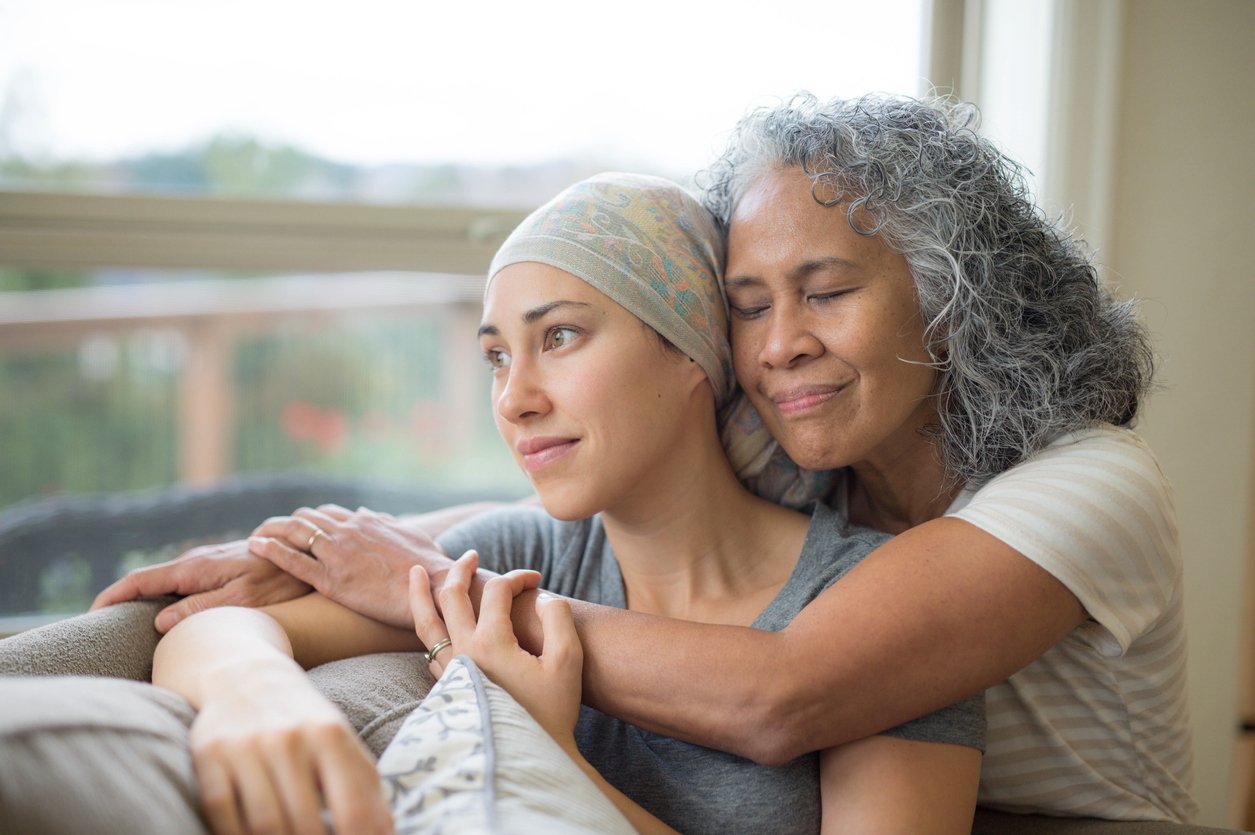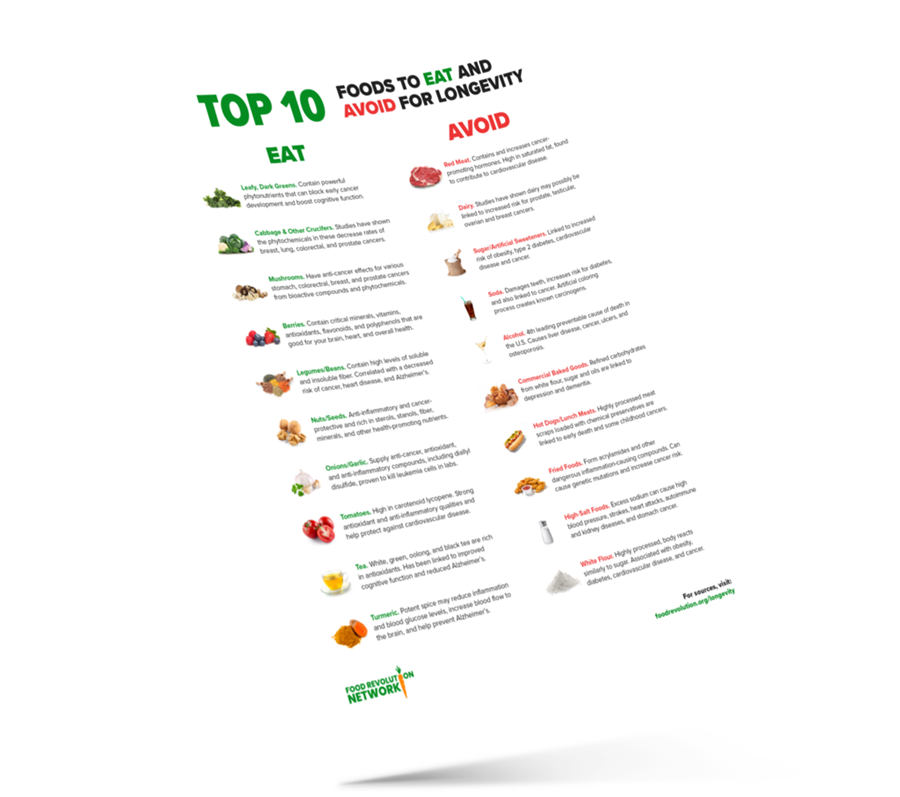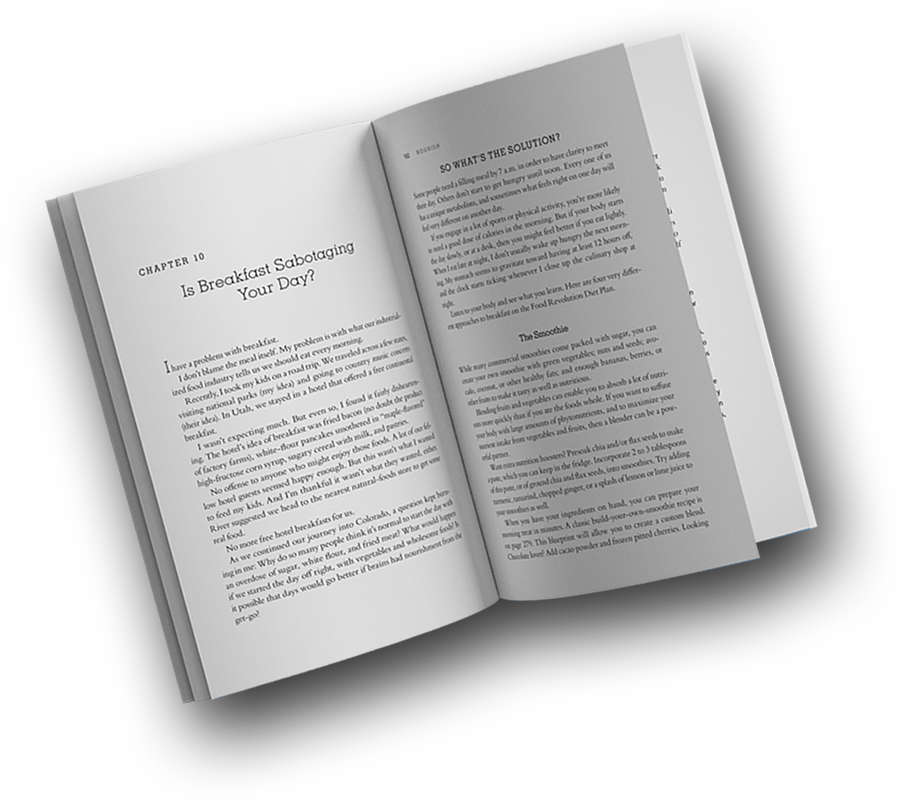On December 23, 1971, then-US President Richard Nixon signed the National Cancer Act, which earmarked hundreds of millions of dollars a year for the National Cancer Institute. Perhaps still cruising on the positive vibes following the successful moon landing two years earlier, Nixon expressed confidence that the so-called “War on Cancer” would lead to a cure within five years.
Unfortunately, it’s now been over 50 years, and cancer is still very much with us.
But cancer science has indeed made progress. Some cancers, like childhood leukemia, which had a 99% fatality rate in 1955, are largely curable these days. New drugs can add years of life to many people diagnosed with multiple myeloma. And many cancers have morphed from death sentences into manageable chronic conditions. Gene-editing technology also promises many more potential medical treatment advances in the years to come.
That’s the good news.
The less good news is that cancer is still a leading killer worldwide, accounting for nearly 10 million deaths every year (that’s nearly one-sixth of all deaths from all causes). And there’s a concerning uptick in cancer cases among people younger than 50, with the largest increases among those aged 30–39.
No matter what age it occurs, cancer can be a devastating disease physically, emotionally, and financially. And those burdens are often shared by friends and families. The financial toll can be especially disastrous if the person and their family lack the financial resources to take time off work or don’t have insurance.
Globally, the cost of cancers diagnosed between 2020–2050 is estimated to reach an almost incomprehensible $25.2 trillion. (To help wrap my head around that amount, I calculated that it would be enough money to provide $3,000 to every human being on Earth — with a trillion dollars to spare.)
Some researchers wonder, then, if the original framing of waging a “war” against cancer was a mistake. Viewing cancer as an external enemy took focus away from the value of prevention, which, in all likelihood, could have kept many cases of cancer from developing in the first place.
A lot of research over the last 50 years has pointed to the pivotal role of dietary and lifestyle choices in influencing cancer risk. In fact, one conservative estimate found that 30–40% of all cancers may be preventable with diet and lifestyle measures alone. (In case you’re keeping track, that could lead to savings of up to $10 trillion, and 120 million lives, over the next 30 years, which doesn’t sound too shabby to me.)
So what are these measures? How can you potentially prevent cancer in yourself or a loved one? In this article, we’ll look at 12 ways to reduce cancer risk.
What Can You Do to Help Prevent Cancer?

While many diet and lifestyle strategies have research behind them showing they can help prevent cancer, there are no guarantees in life. There are many different factors that may contribute to a cancer diagnosis. Everyone is biologically different. And what works for one person may not work for another.
But if you want to give yourself the best chance of preventing a cancer diagnosis, there are a few strategies that may help eliminate exposure to harmful cancer-causing chemicals and dietary compounds, along with preventing oxidative stress — a known contributor to carcinogenesis — in the body.
1. Don’t Smoke or Vape Tobacco
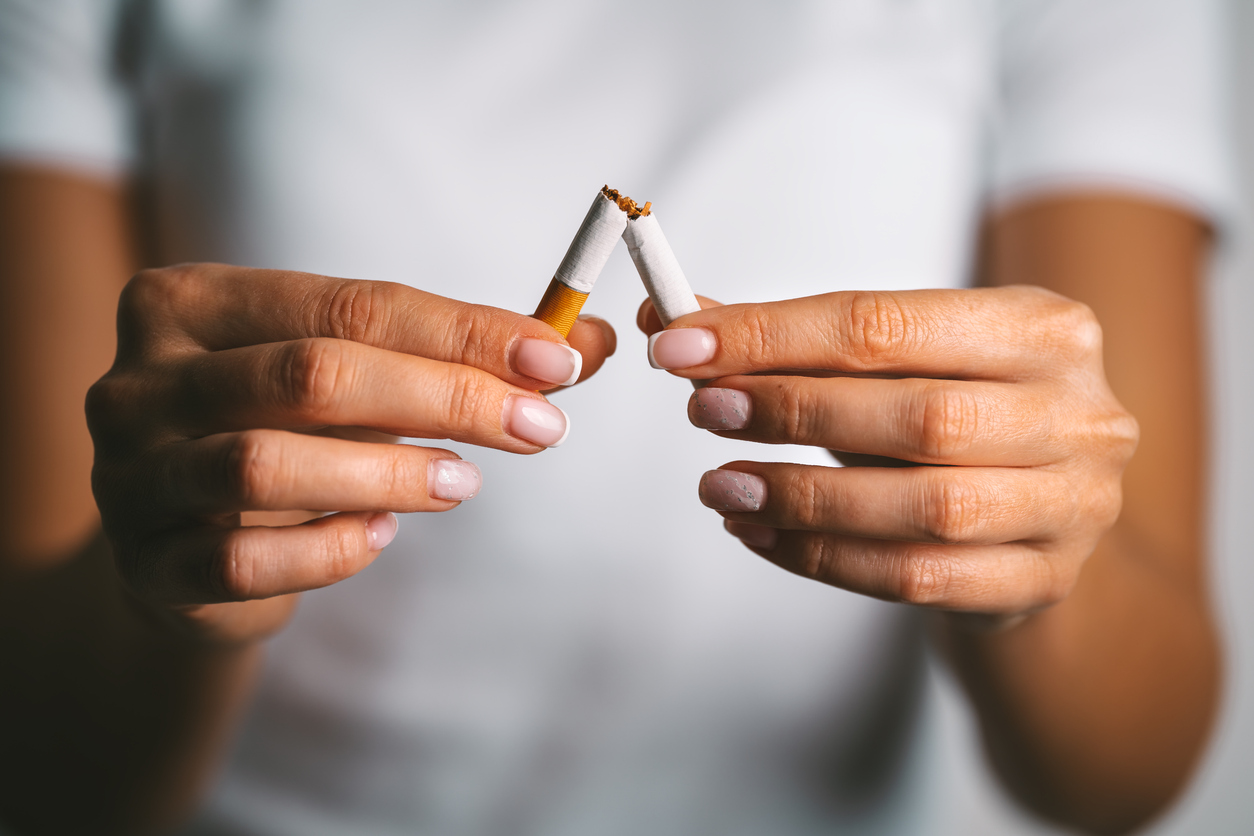
Tobacco smoking is the leading cause of cancer in the US and accounts for 25% of all cancer deaths globally (including the majority of lung cancers). Cigarette smoke contains numerous carcinogens, including polycyclic aromatic hydrocarbons (PAHs), N-nitrosamines, aromatic amines, 1,3-butadiene, benzene, aldehydes, and ethylene oxide.
And while smokers’ risk of lung cancer can be a whopping 22 times higher than that of nonsmokers, smoking increases the risk of many other types of cancer as well. Associations also exist between smoking and skin cancer, prostate cancer, multiple myeloma, endometrial carcinoma, and breast cancer
While the long-term effects of vaping and e-cigarettes are as of yet unknown, preliminary research suggests that they may also increase cancer risk. Similarly, vaping can expose you to nasty-sounding carcinogens such as nicotine derivatives (nitrosonornicotine and nitrosamine ketone), PAHs, heavy metals, and complex organic compounds such as formaldehyde.
While quitting smoking at any age can improve your health, doing so at a young age can significantly lower cancer incidence and increase life expectancy.
2. Avoid Plastics
Plastics are another environmental toxin linked to an elevated risk of cancer. This is most clearly seen where plastic exposure is the greatest such as in occupational exposure during manufacturing.
But as industrially-produced plastics continue to grow and infiltrate our lives, it’s harder and harder to find water, food, or soil that doesn’t contain microplastics. Even more concerning is their ability to find their way into living tissue due to their tiny size. While researchers first noticed microplastics in the flesh of marine creatures, now studies show they’re increasingly prevalent in human bodies as well.
Even if you avoid seafood and don’t work in a factory that produces or uses plastic, you still risk exposure to potentially carcinogenic chemicals from plastics found in everyday items.
Plastic packaging for food products can leach harmful chemicals into that food, especially if the contents are heated or acidic (like tomato sauce). Two of the most frequently implicated plastic chemicals are BPA and phthalates.
BPA may cause metabolic disease, obesity, infertility, and ADHD; while phthalates, as endocrine disruptors, can compromise pregnancy, child growth, and reproductive system development. Both chemicals have links to cancer.
BPA has a role in promoting several hormone-dependent cancers (breast, ovarian, and prostate). Exposure to phthalates during childhood is associated with an increased incidence of childhood osteosarcoma (bone cancer) and lymphoma (blood and lymph cancers).
BPA and phthalates aren’t limited to food packaging, however. They’re also in toys, medications, and beauty and personal care products.
The plastics industry has responded to growing concern by using plastics touted as “BPA-free” and “phthalate-free.” But the problem is, other chemicals found in plastics — nearly every type of plastic — turn out to be toxic as well.
It’s not clear whether swapping one type of plastic for another will pay health dividends, at least not nearly as much as finding ways to reduce overall exposure to plastic. Reducing your plastic footprint benefits not just you, but the wider environment.
You can replace plastic food containers with safer ones that have the added benefit of being long-lasting. And for both health and environmental reasons, you can eliminate, as much as possible, highly wasteful and polluting single-use plastics from your life.
Here are nine tips to help you live without plastic (yes, it really is possible!).
3. Avoid Processed Foods and Meats
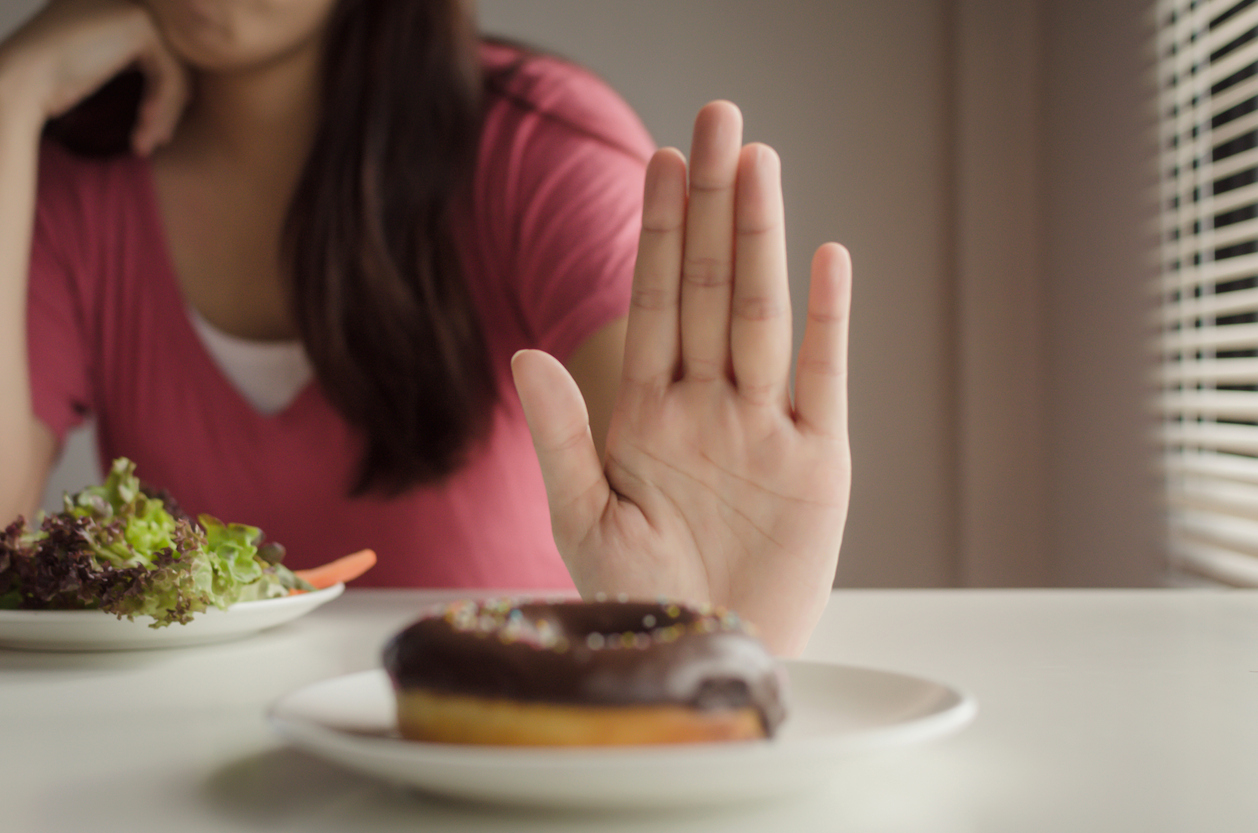
Now it’s time to talk about food. Many processed foods contain harmful cancer-causing ingredients. While many countries have banned these ingredients, they’re still very much a part of the ultra-processed US food system.
A 2023 study found that eating large amounts of ultra-processed food is associated with a higher risk of developing cancers of the upper digestive tract, such as mouth, throat, and esophageal cancer.
Processed meat, in particular, has been associated with increased cancer risk. The World Health Organization (WHO) classified it as a class 1 carcinogen back in 2015. Specifically, a comprehensive 2021 meta-analysis found that processed meat consumption was associated with “a 6% greater breast cancer risk, an 18% greater colorectal cancer risk, a 21% greater colon cancer risk, a 22% greater rectal cancer risk, and a 12% greater lung cancer risk.”
Fortunately, it’s possible to replicate a lot of the taste and texture of processed meats with plant-based alternatives. Some are definitely kinder to your health than others. And the healthiest will generally be the ones you make yourself. You can even make bacon out of plants!
4. Filter Your Water
Multiple carcinogens exist in drinking water, too. Some, like arsenic, occur naturally, while others are the result of contamination from industry or agriculture. Still others are created when chlorine, used to disinfect tap water, comes into contact with organic material.
The 2000 movie Erin Brockovich told the true story of a town’s contaminated water supply. Unfortunately, a 2022 survey of US federal and state water testing found that the tap water of more than 250 million Americans still has dangerously high levels of this contaminant (chromium-6).
A 2023 study found that the tap water consumed by half of all households in the US is contaminated with cancer-causing PFAS, or “forever chemicals,” so named because they’re extremely resistant to breaking down, either in the environment or the body.
Microplastics are also increasingly concentrated in drinking water.
For tips on how you can treat your drinking water to reduce health risks, check out this comprehensive article on drinking water treatment.
Editor’s Note: Having a good home water filter is a great way to protect your family (and to save money over buying bottled water, which typically comes in plastic). One option that FRN likes is the AquaTru — a countertop RO unit that includes excellent carbon filter technology, delivers high-quality water and flavor, slashes the purchase cost, requires no installation fees, is remarkably water-efficient, and has extremely minimal maintenance costs. The manufacturer, AquaTru, states that their system removes chromium-6, arsenic, PFAS, and a great many other contaminants. It’s available for a $100 discount for FRN members. If you’re interested, you can find out more here.
5. Filter Your Air
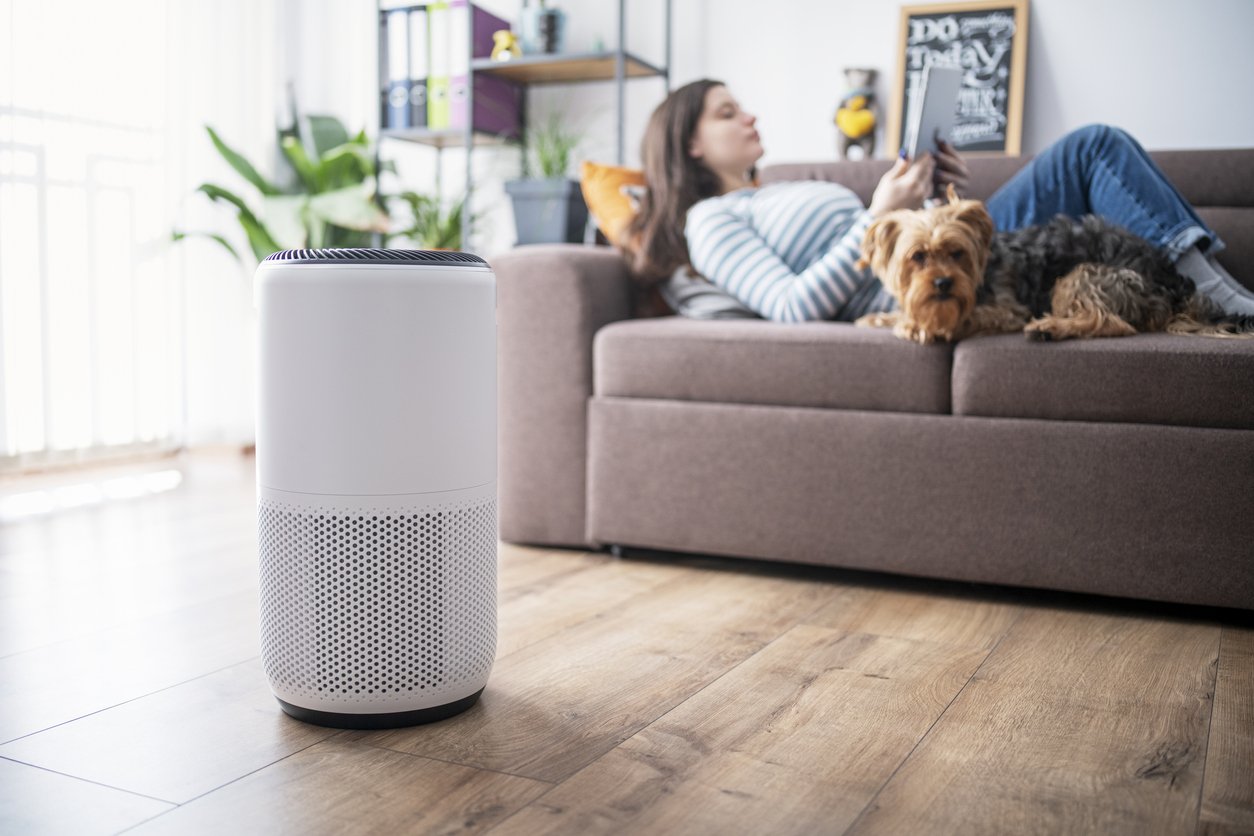
While many people think that lung cancer only happens to smokers, up to 29% of all lung cancer deaths are attributable to poor air quality. Some of this comes from outdoor pollution, including car exhaust, factory and power plant emissions, and wildfire smoke, which can travel indoors, where the carcinogenic particles can become even more concentrated.
Your home is also a potential source of airborne cancer-causing chemicals. Cooking with a gas stove, it turns out, can be more of a contributor to carcinogenic air than even second-hand cigarette smoke. Gas stoves can raise indoor levels of benzene, a carcinogen linked to leukemia and other blood cell cancers.
VOCs, or volatile organic compounds, are chemicals that can off-gas from cleaning supplies, paints, insecticides, lacquers and stains, and many other products. Some of these are suspected human carcinogens, as well as having multiple other health effects.
Another chemical that can build up in the home and raise the risk of cancer is radon, a naturally occurring radioactive gas that can cause lung cancer. You can get your home tested, and if levels are high, you can either increase the rate of airflow, get a suitable home air filter, or install an underground ventilation system to divert the gas before it enters your living spaces.
To find out more on the top sources and stunning health effects of indoor air pollution, and what you can do about it, see our article, here.
6. Reduce Your Stress
There are also internal contributors to cancer development: how we process stressors. While the stress response is a crucial system that has evolved to keep us safe in the presence of a threat, many people experience a chronic stress response that remains active even in the absence of an external threat.
Animal studies (our view on the use of animals in medical research is here) and lab-grown human cancer cells have provided evidence that chronic stress may cause cancer to get worse and spread. That’s because prolonged stress triggers inflammation, suppresses immunity, and promotes tumor growth, angiogenesis, and metastasis.
There’s also evidence that persistent and chronic stress exposure might also contribute to tumor initiation in specific cancers.
While you can’t avoid all of life’s stressors, there are some proven strategies that can help you manage stress more effectively. Certain foods can help (here are seven of them.) And adaptogens are plants and herbs that could be especially useful in helping your body deal with stressors and come back into balance.
Exercising and spending time in nature are also documented ways of lowering stress levels. For an added boost of calm, you can do both at the same time, an approach known as green fitness.
7. Use (Natural) Sunscreen

Skin cancer accounts for almost one-third of all diagnosed cancers, and the incidence of both melanoma and nonmelanoma skin cancers has been increasing over the past decades.
The main factors that predict the development of melanoma appear to be a combination of a history of sunburn from ultraviolet radiation and continued recreational exposure to the sun.
One way to keep the sun from damaging your skin is by using sunscreen. Studies have shown that it does reduce the risk of skin cancers. Unfortunately, not all sunscreens are benign. Some contain benzophenone, a suspected carcinogen that also can interfere with key hormones and reproductive organs.
It’s ironic that many people who seek to avoid one type of cancer end up doing so with products that promote other cancers, as well as additional health problems. To avoid this “from-the-frying-pan-into-the-fire” scenario, look for natural sunscreens or other forms of natural sun protection. There are even foods that can protect your skin from harmful UV radiation.
For advice on what to look for in a natural sunscreen, see our article, here.
8. Wash Produce to Remove Pesticides
The greatest cancer risk associated with pesticides is occupational, affecting farm workers who apply pesticides. However, there may also be a risk from dietary sources. Estimates put more than 90% of the US population with detectable concentrations of pesticide biomarkers in their urine or blood.
While many fruits and vegetables are potent cancer-fighters, some of the pesticides used to grow them promote tumor growth, as well as cause harmful gene expression and DNA modification. For example, a 2021 study found a correlation between dietary exposure to pesticides and increased breast cancer risk among postmenopausal women.
But there are several things you can do to minimize your exposure to these potentially carcinogenic compounds. If you can access and afford organic produce, that’s a great way to keep some of the worst pesticide offenders off your plate.
If a 100% organic shopping cart is out of your reach, you can get the most pesticide-free bang for your buck by going organic with the most pesticide-contaminated produce aka “the Dirty Dozen.”
And while you can’t remove all pesticide residue by washing your produce, a water and baking soda mixture can get rid of some pesticides.
For more on how to wash produce to remove the vast majority of pesticide residues, see our article here.
9. Use Nontoxic Cookware

Even after buying organic and washing off as much pesticide residue as you can, you may still be cooking your produce in ways that increase cancer risk. That’s because some nonstick cookware has a coating of carcinogenic chemicals.
The two biggest culprits are poly- and perfluoroalkyl substances (PFAs) and perfluorooctanoic acid (PFOA). PFOA is widely used in the manufacture of a bunch of industrial and commercial products, including Teflon coating on cookware. It’s associated with several cancers, including those of the testicles and kidneys, as well as pancreatic cancer.
To avoid these chemicals, check out some of our suggestions on healthy cookware options.
10. Drink Less (or No) Alcohol
While the media and wellness influencers debate the pros and cons of red wine for heart health, the evidence is clear and increasingly compelling that alcoholic beverages qualify as group 1 carcinogens. This doesn’t mean they get to board airplanes first. Rather, “group 1” is used by the WHO to indicate that there’s “convincing evidence that the agent causes cancer” in humans.
Drinking alcohol increases the risk of several cancer types, including cancers of the upper digestive tract, liver, colorectum, and breast. Worldwide, about 4% of cancers have a correlation with alcohol consumption.
But how much alcohol do you need to drink before your risk of cancer increases? According to the WHO, there’s no safe level of alcohol consumption. While the risk of developing cancer increases substantially the more alcohol you consume, even light or moderate consumption raises your odds of developing cancer.
Find out more on how alcohol affects your health here, and get some suggestions on nonalcoholic or mocktail recipes here.
11. Get Regular Cancer Screenings
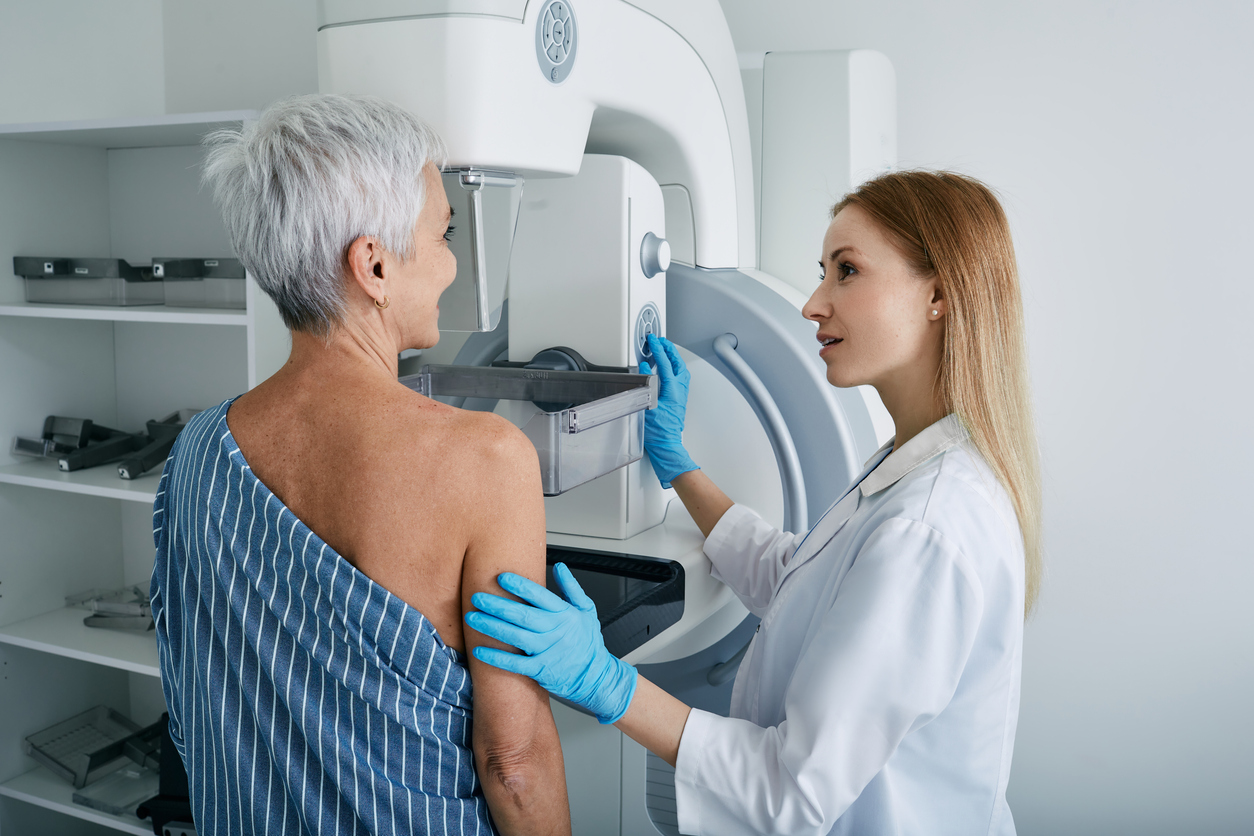
Although no substitute for prevention, it’s often true that early detection can be a lifesaver. Getting regular cancer screenings can enable your health care provider to find precancerous cells as well as cancerous tumors.
Specifically, medical societies recommend screening for cancers that are easier to treat and cure when found early. For example, screenings can prevent colorectal and cervical cancers by identifying and removing precancerous lesions before they become cancerous.
Recent studies are also showing that mammography screenings decrease women’s risk of dying from breast cancer. A large-scale 2020 study out of Sweden found that women who participated in mammograms reduced their risk of dying of breast cancer within 10 years by a whopping 41%.
Another screening success has been the Pap smear, which I just learned was named after Dr. Georgios Papanikolaou, the Greek pathologist who discovered the test and publicized it in 1943. Over the past three decades, its widespread use has been credited with decreasing cervical cancer incidence and mortality by over 50%.
Colonoscopies that look for colorectal cancer may also be beneficial once people have reached a certain age. (According to the American Cancer Society, that age is 45 for folks with “average risk”).
Keep in mind, however, that there are also risks involved in all cancer screenings, including false positives that can lead to invasive treatments, as well as aggressively treating tumors that may be so slow-growing as to represent little threat to health.
Additionally, certain cancer screening tests may only be suggested for people who are high-risk. Others are routine tests done regularly after a certain age. To find out what cancer screenings are recommended by the American Cancer Society, here’s a resource they put together.
And remember the adage that an ounce of prevention is worth a pound of cure. For most of us, the best prevention is a healthy diet and lifestyle. Starting with choosing to…
12. Eat Cancer-Fighting Foods
While most of the items on this list are things to avoid — tobacco smoke, plastics, processed foods, etc. — there are also things you can add more of to help prevent cancer.
Vegetable and fruit consumption is associated with a lower risk of many cancers, including those of the stomach, esophagus, lung, oral cavity and pharynx, endometrium, pancreas, colon, and others. The effects are likely due to the many positive qualities of whole plant-based foods. But two of the best studied are phytonutrients and fiber.
Phytonutrients and phytochemicals found in colorful plant foods, in particular, have been shown to possess anticancer effects. These and other antioxidants help neutralize free radicals in your cells and fight oxidative stress in your body.
Oxidative stress plays a major role in cancer cell metabolism. Cancer patients frequently have low antioxidant stores, and experience increased oxidative stress, leading researchers to seek ways to increase antioxidant activity as a cancer prevention strategy.
Fiber is another key nutrient for cancer prevention. There’s a clear link between fiber and colorectal health. You can think of fiber as the “broom” that sweeps your colon clean. Studies show that people who consumed just 10 more grams of fiber per day had a 10% reduction in their risk of developing colorectal cancer.
But fiber’s benefit doesn’t stop there. Multiple studies have found that the more fiber you eat, the lower your risk of breast and other hormonal cancers.
For more on why fiber is good for you, including a beautifully designed graphic showing 33 of the best high-fiber foods and a bunch of delicious fiber-rich recipes, check out this article.
And for more on anticancer foods, check out 7 Ways to Eat to Defeat Cancer Today and Every Day by Dr. William Li.
Cancer-Fighting Recipes
While some of the strategies shared in this article may take time and even a bit of expense to implement (changing cookware and sunscreen, replacing plastic containers with glass ones, getting a home air purifier, and so on), you can quickly make a dent in your cancer risk through the food you prepare and eat today.
Here are a few of our favorite anticancer recipes that taste so good, you’ll be forgiven for forgetting how good they are for you.
1. Smashed Edamame Avocado Toast
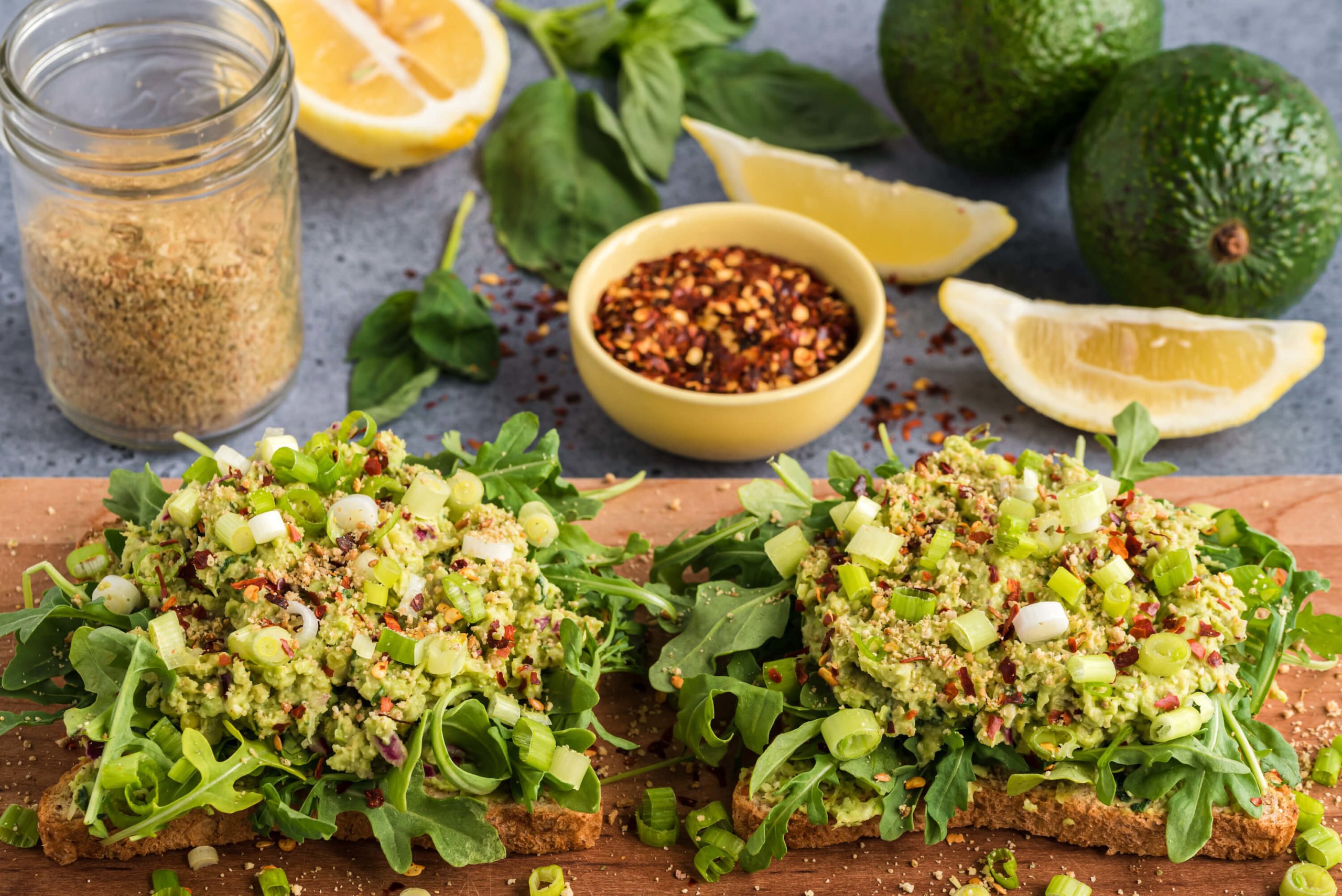
This easy toast recipe delivers a hefty dose of fiber, which is essential for digestive health and reducing the risk of certain types of cancer. Avocado is a nutrient powerhouse, rich in monounsaturated fats and antioxidants, and is known for its anti-inflammatory properties. The star ingredient, however, is edamame, which adds a substantial dose of plant-based protein and isoflavones. These phytonutrients may protect cells from damage and reduce the risk of cancer development. Enjoy the flavors, textures, and nutritional attributes of this craveable breakfast.
2. Strawberry Spinach Salad
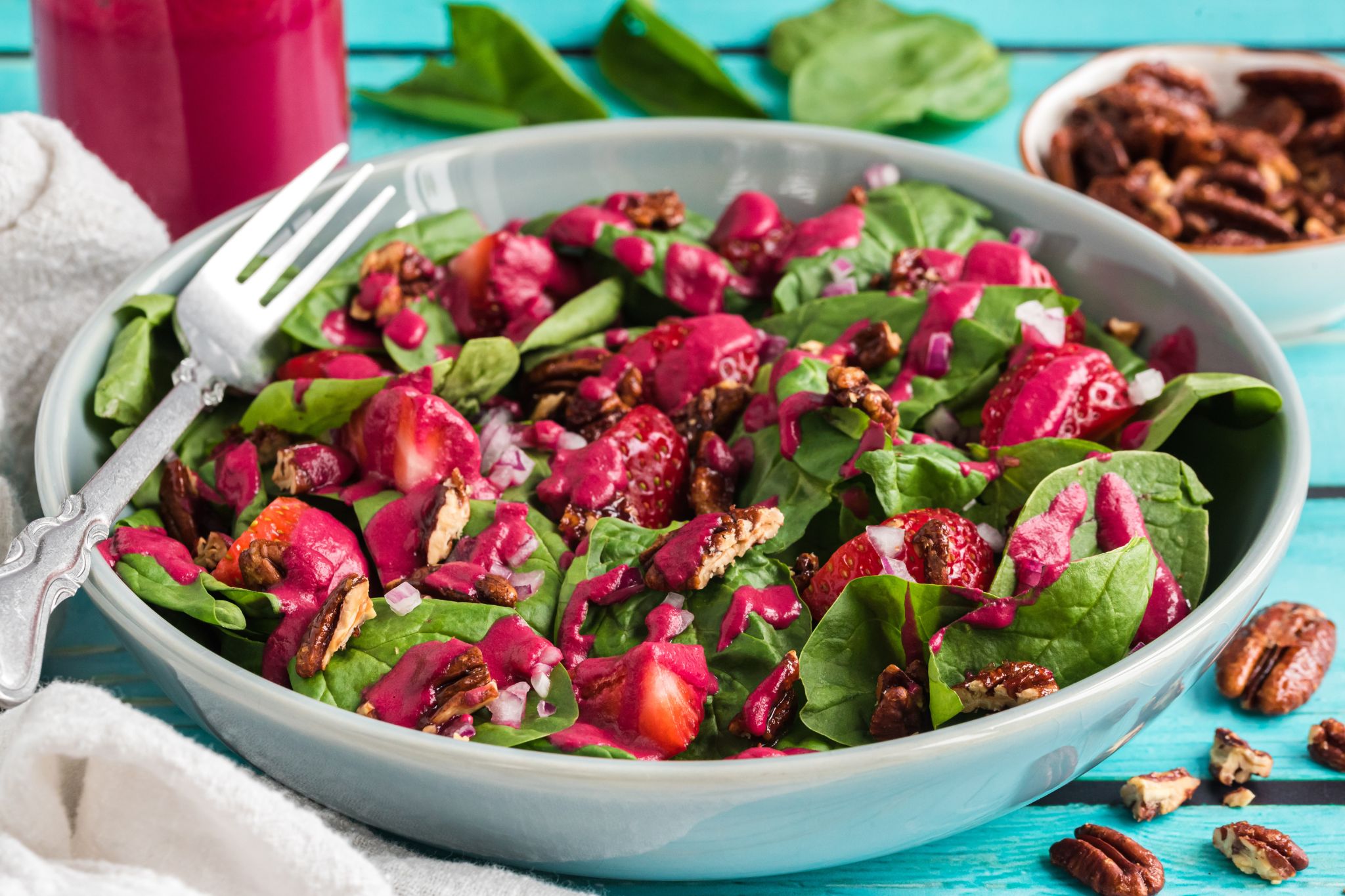
Delight in a vibrant salad bursting with flavor and packed with cancer-fighting nutrients. This colorful ensemble features nutrient-rich spinach, known for its abundance of antioxidant cancer fighters like vitamin C and beta-carotene. It’s also complemented by sweet and succulent strawberries, offering a dose of ellagic acid — a phytonutrient that helps scavenge free radicals. The Strawberry Spinach Salad also provides quercetin — a plant compound with anticancer properties. Topped with a tangy beet balsamic dressing, this salad is a mouthwatering treat and a potential ally in your journey toward cancer prevention.
3. Pink Cauliflower Soup
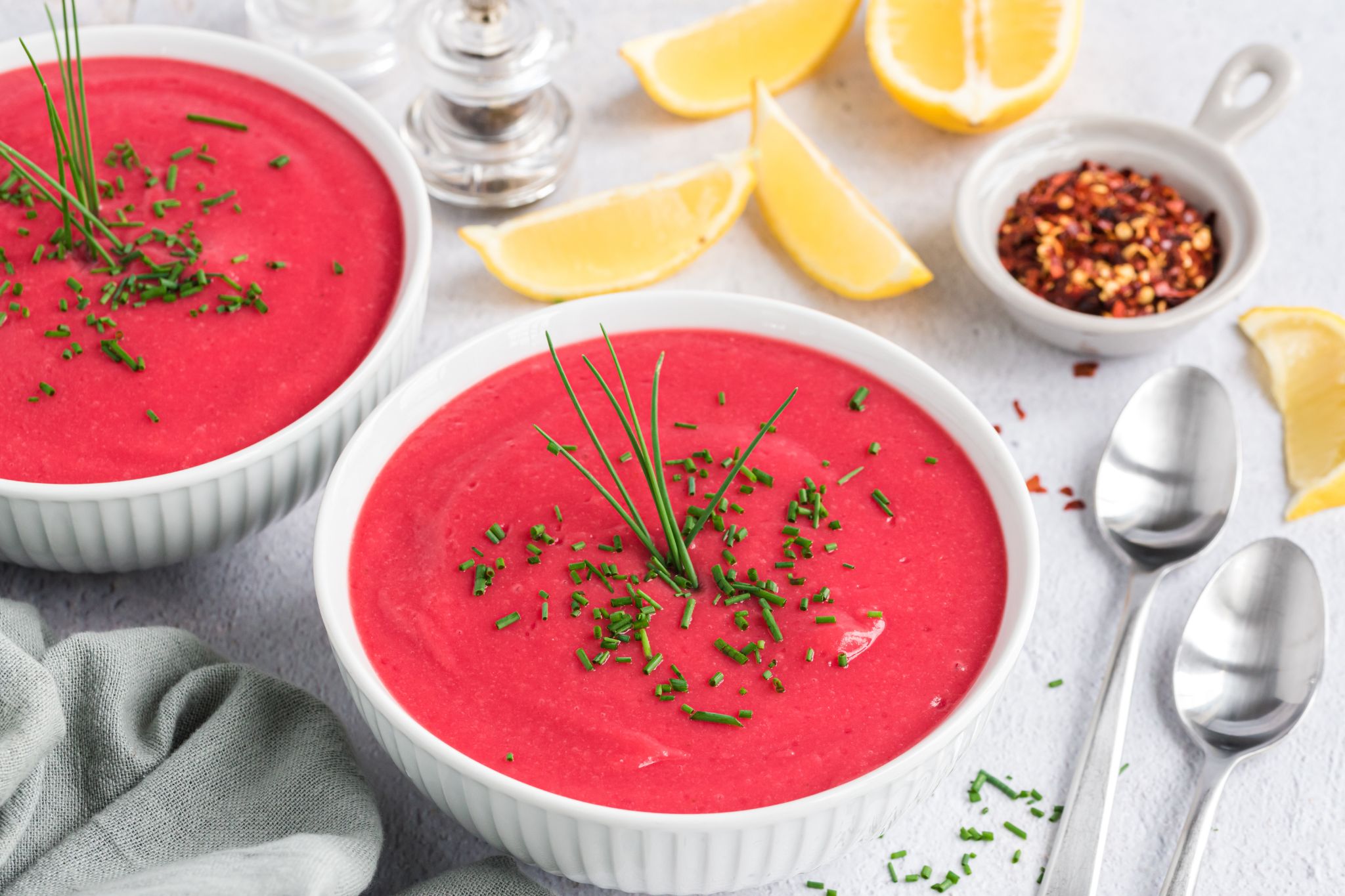
Indulge in a flavorful blend of cauliflower, beets, garlic, tofu, and aromatic spices designed with potential cancer-fighting properties in mind. Cauliflower, a cruciferous vegetable rich in sulforaphane, may assist in reducing the risk of certain cancers by aiding in the body’s natural detoxification processes. Vibrant beets contribute betalains known for their anti-inflammatory properties. And garlic adds allicin, believed to possess powerful anticancer effects. With the addition of delicate microgreens, you’ll also get an extra boost of essential vitamins and minerals.
4. Plant-Powered Lunch Bowl
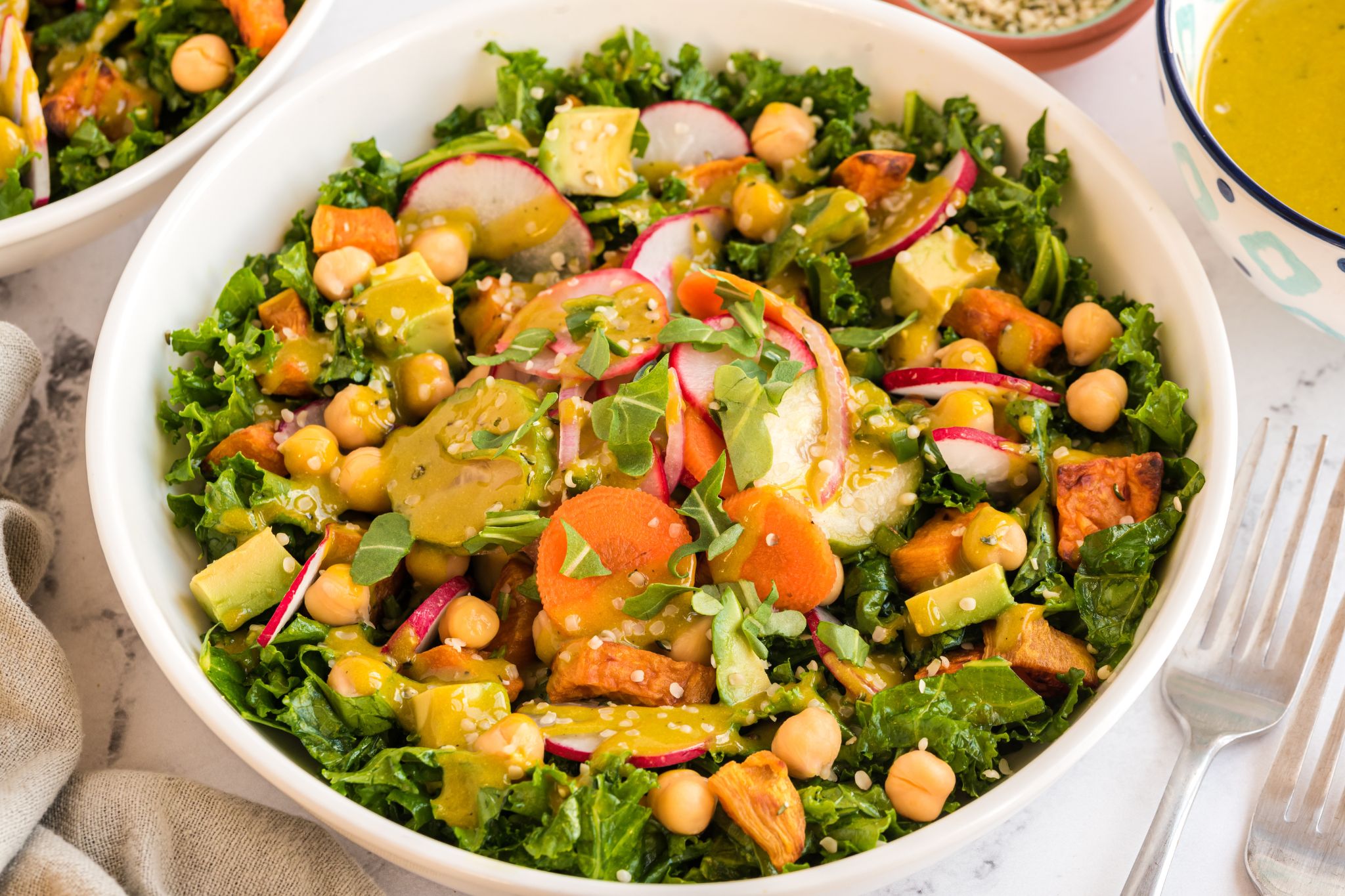
This Plant-Powered Lunch Bowl is a vibrant mix of nutrient-dense kale, antioxidant-packed turmeric, and carotenoid-rich sweet potatoes. Complemented by a vibrant matcha turmeric dressing, this bowl is more than just a delicious meal — it’s a cancer-fighting recipe. The abundance of vitamins, minerals, and phytochemicals from all of the ingredients creates a bowl bursting with health benefits.
5. Rainbow Smoothie
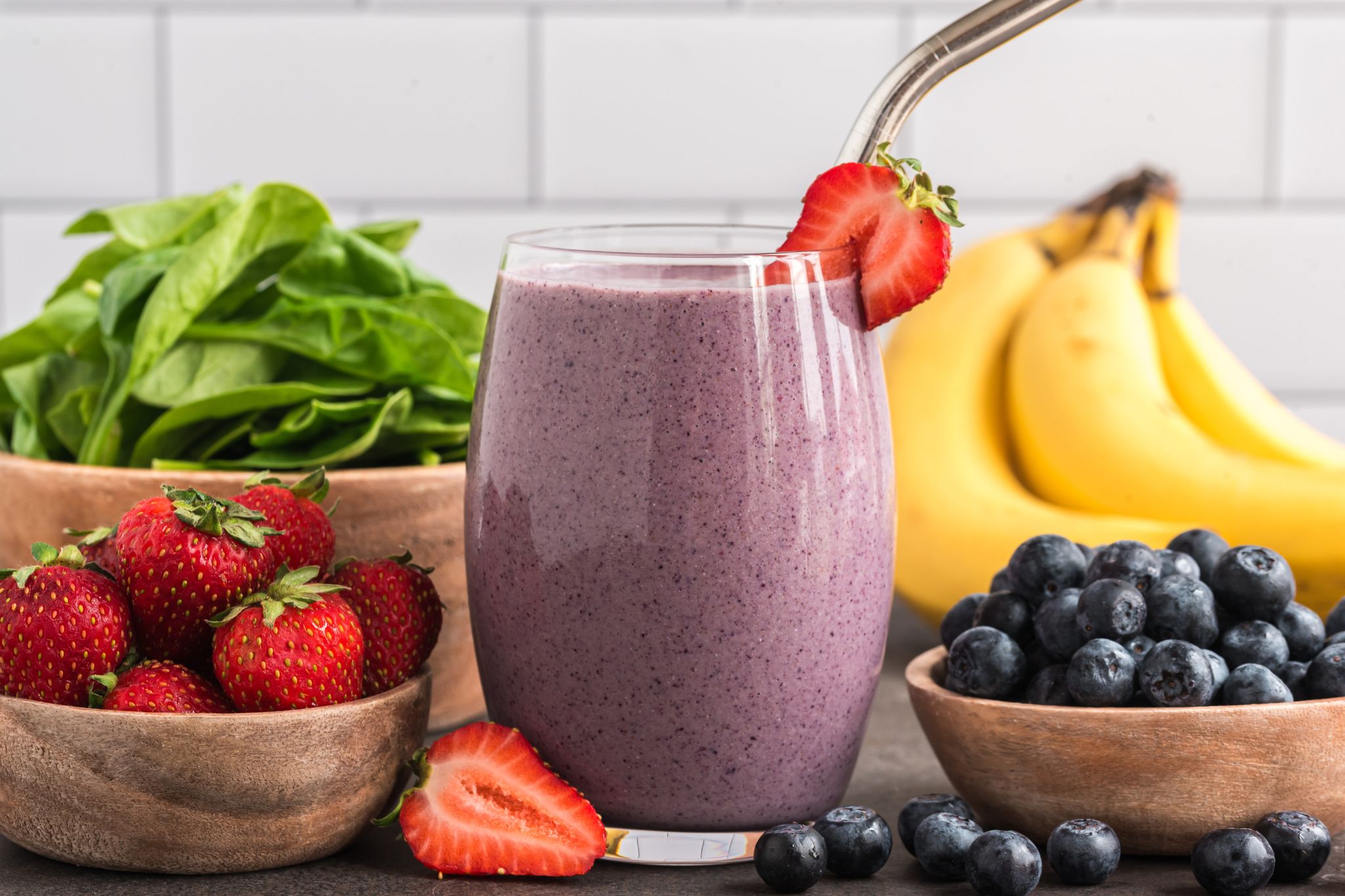
Indulge in a vibrant Rainbow Smoothie, a flavorful concoction blending the goodness of banana, apple, mixed berries, nutrient-rich spinach, and chia seeds, all with potentially cancer-preventive properties. This colorful smoothie offers a wealth of antioxidants, vitamins, and fiber. Both berries, particularly rich in anthocyanins and vitamin C, and spinach, abundant in folate and antioxidants, are believed to combat oxidative stress and inflammation, potentially reducing cancer risk. Combined with the fiber and omega-3 fatty acids from chia seeds, this refreshing smoothie is a nourishing and delightful treat!
Take Control of Your Health with These Cancer Prevention Strategies
Cancer can be devastating. And while medical advances have been largely modest and limited to certain families of cancer, there’s a lot of hope in the form of evidence-based strategies for lifestyle-based cancer prevention.
From steering clear of harmful substances like tobacco and plastics to embracing stress reduction techniques and consuming cancer-fighting foods, there are many steps you can take toward a healthier lifestyle.
While no approach guarantees immunity from cancer, the combination of these measures can significantly reduce your risk. And the collective impact of these lifestyle changes holds promise not just for individual well-being but also for a future in which the devastating impact of cancer is diminished.
Tell us in the comments:
- Which of the 12 cancer-fighting strategies above do you already engage in?
- What’s one thing you can do right now to reduce the risk of cancer for yourself and your loved ones?
- Which cancer-fighting recipe will you make next?
Featured Image: iStock.com/FatCamera
